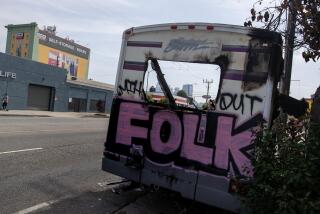Truck Limits Back on Table
Mayor James K. Hahn will revisit a plan to keep big rigs off downtown Los Angeles streets during peak rush hours as part of a new campaign to untangle the city’s notorious traffic problem.
The truck ban is one of several ideas that will be considered by a new task force, assembled by Hahn, that will meet for the first time Monday.
The panel, which includes city, state and regional transportation experts and business representatives, has six months to draft a list of traffic recommendations.
“Some of the things may be as simple as re-striping a street,” said Deputy Mayor Brian Williams.
Among other ideas the task force will consider, according to Williams, is a plan to reverse the flow of street traffic on certain lanes to improve traffic flow.
Also on Monday, Hahn will announce his latest effort to improve 25 of the city’s most dangerous and congested intersections, at a cost of about $1 million.
Since taking office in 2001, Hahn has announced a plan each year to repair and improve 25 of the city’s worst intersections.
Transportation experts say some traffic-busting ideas may be easier to implement than others.
Limiting trucks in downtown Los Angeles during peak commuting hours worked well during the 1984 Olympics, when truckers, warehouse operators and retailers voluntarily adopted alternative schedules.
But when then-Mayor Tom Bradley tried to ban big rigs from city streets in 1990, he ran into legal hurdles and opposition from retailers, warehouse owners and others who would have been forced to pay drivers and other employees overtime salaries to store and ship cargo after hours.
Experts say Hahn may run into some of the same objections, particularly from local merchants whose businesses rely on daily truck deliveries.
“Businesses want their deliveries when they want their deliveries,” said Amelia Regan, an associate professor at the Institute of Transportation Studies at UC Irvine.
Williams said the panel may consider offering truckers incentives to make deliveries during off-peak times.
One incentive, he said, could be to give truckers access to carpool lanes after heavy commuting hours.
Some critics worry that the task force will focus only on increasing traffic flow, at the expense of pedestrian safety.
Deborah Murphy, chairwoman of the city’s Pedestrian Advisory Task Force, said she is disappointed that the mayor had not included an advocate for pedestrians or bicyclists on the panel.
But others applauded Hahn for tackling a problem that is the bane of nearly every Southern California resident.
“Mayor Hahn has had other top priorities during the first two years in office,” said USC law professor Erwin Chemerinsky, who helped lead a government reform effort in City Hall. “The most important issue in the city that has not received his attention is transportation.”
Some transportation experts say the region’s traffic problems have become so pervasive that only dramatic and unconventional ideas will make a difference.
“It’s time to think of some better ideas other than just more of the same,” said Robert Poole, director of transportation studies for the Reason Foundation, a conservative think tank.
Poole suggested the mayor consider an idea called “congestion pricing,” in which motorists would pay freeway tolls that increased during heavy travel times.
“We’ve spent many millions of dollars on rail transit systems and carpool lanes, and yet even in L.A. the number on transit and carpools has barely budged,” he said.
More to Read
Sign up for Essential California
The most important California stories and recommendations in your inbox every morning.
You may occasionally receive promotional content from the Los Angeles Times.


![Los Angeles, CA - May 19: Carlos Vargas, left, and Paulina Rubio, members of the harm reduction team from Homeless Outreach Program Integrated Care Systems [HOPICS], a leading homeless services and housing agency, look for drug addicts to help and pass out supplies at a homeless RV encampment along 77th St. in South Los Angeles Friday, May 19, 2023. The team hands out syringes, fentanyl test strips, overdose reversal nose spray and medication to prevent overdoses, infection and disease transmission, including the HIV virus. Fenanyl is particularly insidious because it can be found in all other drugs, especially meth and heroin. The handouts are also meant to reduce infection through broken pipes, which can cut users mouths and open them to infection. . (Allen J. Schaben / Los Angeles Times)](https://ca-times.brightspotcdn.com/dims4/default/530e2db/2147483647/strip/true/crop/3900x2608+0+34/resize/320x214!/quality/75/?url=https%3A%2F%2Fcalifornia-times-brightspot.s3.amazonaws.com%2Fe9%2F77%2F4b8bd35d4881a3edec6b945b143b%2F1298639-me-soaring-fentanyl-deaths-24-1-ajs.jpg)








